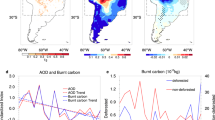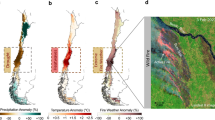Abstract
The El Niño/Southern Oscillation (ENSO) has a pronounced influence on year-to-year variations in climate1. The response of fires to this forcing2 is complex and has not been evaluated systematically across different continents. Here we use satellite data to create a climatology of burned-area and fire-emissions responses, drawing on six El Niño and six La Niña events during 1997–2016. On average, reductions in precipitation and terrestrial water storage increased fire emissions in pan-tropical forests by 133% during and following El Niño as compared with La Niña. Fires peaked in equatorial Asia early in the ENSO cycle when El Niño was strengthening (Aug–Oct), before moving to southeast Asia and northern South America (Jan–Apr), Central America (Mar–May) and the southern Amazon (Jul–Oct) during the following year. Large decreases in fire occurred across northern Australia during Sep–Oct of the second year from a reduced fuel availability. Satellite observations of aerosols and carbon monoxide provided independent confirmation of the spatiotemporal evolution of fire anomalies. The predictable cascade of fire across different tropical continents described here highlights an important time delay in the Earth system’s response to precipitation redistribution. These observations help to explain why the growth rate of atmospheric CO2 increases during El Niño3 and may contribute to improved seasonal fire forecasts.
This is a preview of subscription content, access via your institution
Access options
Access Nature and 54 other Nature Portfolio journals
Get Nature+, our best-value online-access subscription
9,800 Yen / 30 days
cancel any time
Subscription info for Japanese customers
We have a dedicated website for our Japanese customers. Please go to natureasia.com to subscribe to this journal.
Buy this article
- Purchase on SpringerLink
- Instant access to full article PDF
Prices may be subject to local taxes which are calculated during checkout





Similar content being viewed by others
References
McPhaden, M. J., Zebiak, S. E. & Glantz, M. H. ENSO as an integrating concept in Earth science. Science 314, 1740–1745 (2006).
van der Werf, G. R. et al. Continental-scale partitioning of fire emissions during the 1997 to 2001 El Niño/La Niña period. Science 303, 73–76 (2004).
Betts, R. A., Jones, C. D., Knight, J. R., Keeling, R. F. & Kennedy, J. J. El Niño and a record CO2 rise. Nat. Clim. Change 6, 806–810 (2016).
Keeling, C. D., Whorf, T. P., Wahlen, M. & Vanderplicht, J. Interannual extremes in the rate of rise of atmospheric carbon-dioxide since 1980. Nature 375, 666–670 (1995).
Bradley, R. S., Diaz, H. F., Kiladis, G. N. & Eischeid, J. K. ENSO signal in continental temperature and precipitation records. Nature 327, 497–501 (1987).
Mason, S. J. & Goddard, L. Probabilistic precipitation anomalies associated with ENSO. Bull. Am. Meteorol. Soc. 82, 619–638 (2001).
Curtis, S. & Adler, R. F. Evolution of El Niño–precipitation relationships from satellites and gauges. J. Geophys. Res. D 108, 4153 (2003).
Chen, Y., Morton, D. C., Andela, N., Giglio, L. & Randerson, J. T. How much global burned area can be forecast on seasonal time scales using sea surface temperatures? Environ. Res. Lett. 11, 045001 (2016).
Duffy, P. A., Walsh, J. E., Graham, J. M., Mann, D. H. & Rupp, T. S. Impacts of large-scale atmospheric–ocean variability on Alaskan fire season severity. Ecol. Appl. 15, 1317–1330 (2005).
van der Werf, G. R. et al. Climate regulation of fire emissions and deforestation in equatorial Asia. Proc. Natl Acad. Sci. USA 105, 20350–20355 (2008).
Chen, Y. et al. Forecasting fire season severity in South America using sea surface temperature anomalies. Science 334, 787–791 (2011).
Andela, N. & van der Werf, G. R. Recent trends in African fires driven by cropland expansion and El Niño to La Niña transition. Nat. Clim. Change 4, 791–795 (2014).
Shabbar, A., Skinner, W. & Flannigan, M. D. Prediction of seasonal forest fire severity in Canada from large-scale climate patterns. J. Appl. Meteorol. Clim. 50, 785–799 (2011).
Armenteras-Pascual, D. et al. Characterising fire spatial pattern interactions with climate and vegetation in Colombia. Agric. Forest Meteorol. 151, 279–289 (2011).
Greenville, A. C., Dickman, C. R., Wardle, G. M. & Letnic, M. The fire history of an arid grassland: the influence of antecedent rainfall and ENSO. Int. J. Wildland Fire 18, 631–639 (2009).
Goodrick, S. L. & Hanley, D. E. Florida wildfire activity and atmospheric teleconnections. Int. J. Wildland Fire 18, 476–482 (2009).
Changnon, S. A. Impacts of 1997–98 El Niño-generated weather in the United States. Bull. Am. Meteorol. Soc. 80, 1819–1827 (1999).
Duncan, B. N. et al. Indonesian wildfires of 1997: impact on tropospheric chemistry. J. Geophys. Res. D 108, 4458 (2003).
Randerson, J. T., Chen, Y., van der Werf, G. R., Rogers, B. M. & Morton, D. C. Global burned area and biomass burning emissions from small fires. J. Geophys. Res. G 117, G04012 (2012).
Giglio, L., Randerson, J. T. & Van der Werf, G. R. Analysis of daily, monthly, and annual burned area using the fourth-generation global fire emissions database (GFED4). J. Geophys. Res. G 118, 317–328 (2013).
van der Werf, G. R. et al. Global fire emissions estimates during 1997–2016. Earth Syst. Sci. Data 9, 697–720 (2017).
Stein, K., Timmermann, A., Schneider, N., Jin, F. F. & Stuecker, M. F. ENSO seasonal synchronization theory. J. Climate 27, 5285–5310 (2014).
Wang, C. Z. Atmospheric circulation cells associated with the El Niño–Southern Oscillation. J. Clim. 15, 399–419 (2002).
Chen, Y., Velicogna, I., Famiglietti, J. S. & Randerson, J. T. Satellite observations of terrestrial water storage provide early warning information about drought and fire season severity in the Amazon. J. Geophys. Res. G 118, 495–504 (2013).
Nepstad, D. C. et al. The role of deep roots in the hydrological and carbon cycles of Amazonian forests and pastures. Nature 372, 666–669 (1994).
Spessa, A. C. et al. Seasonal forecasting of fire over Kalimantan, Indonesia. Nat. Hazards Earth Syst. Sci. 15, 429–442 (2015).
Kirtman, B. P. et al. The North American multimodel ensemble: phase-1 seasonal-to-interannual prediction; phase-2 toward developing intraseasonal prediction. Bull. Am. Meteorol. Soc. 95, 585–601 (2014).
Staver, A. C., Archibald, S. & Levin, S. A. The global extent and determinants of savanna and forest as alternative biome states. Science 334, 230–232 (2011).
Johnston, F. H. et al. Estimated global mortality attributable to smoke from landscape fires. Environ. Health Persp. 120, 695–701 (2012).
Collins, M. et al. in Climate Change2013: The Physical Science Basis (eds T. F. Stocker et al.) Ch. 12, 1029–1136 (Cambridge Univ. Press, Cambridge, 2013).
Reynolds, R. W., Rayner, N. A., Smith, T. M., Stokes, D. C. & Wang, W. Q. An improved in situ and satellite SST analysis for climate. J. Clim. 15, 1609–1625 (2002).
Giglio, L., Kendall, J. D. & Mack, R. A multi-year active fire dataset for the tropics derived from the TRMM VIRS. Int. J. Remote Sensing 24, 4505–4525 (2003).
Arino, O., Rosaz, J.-M. & Goloub, P. The ATSR World Fire Atlas. A synergy with ‘Polder’ aerosol products. Earth Obs. Quart. 64, 1–6 (1999).
Acknowledgements
Y.C., N.A. and J.T.R. received funding support from the Gordon and Betty Moore Foundation (GBMF3269). J.T.R. received additional support from NASA’s Terrestrial Hydrology, Interdisciplinary Science and Carbon Monitoring System programs. D.M. was supported by NASA’s Interdisciplinary Science and Carbon Monitoring System Programs. G.v.d.W. was supported by the European Research Center (grant 280061). We thank the NOAA State of the Ocean website, the NASA Langley Research Center Atmospheric Science Data Center, the NOAA ESRL Physical Sciences Division and the NASA MEaSUREs Program for providing data used in this analysis.
Author information
Authors and Affiliations
Contributions
Y.C. and J.T.R. designed the study, Y.C. conducted the analysis, Y.C., D.C.M., N.A. and J.T.R. wrote the manuscript. G.v.d.W. and L.G. contributed to the interpretation of the fire-emissions and burned-area observations. All the authors contributed to the manuscript preparation and editing.
Corresponding author
Ethics declarations
Competing interests
The authors declare no competing financial interests.
Additional information
Publisher’s note: Springer Nature remains neutral with regard to jurisdictional claims in published maps and institutional affiliations.
Electronic supplementary material
Supplementary Information
Supplementary Tables 1–4, Supplementary Figures 1–7, Supplementary Section 1
Rights and permissions
About this article
Cite this article
Chen, Y., Morton, D.C., Andela, N. et al. A pan-tropical cascade of fire driven by El Niño/Southern Oscillation. Nature Clim Change 7, 906–911 (2017). https://doi.org/10.1038/s41558-017-0014-8
Received:
Accepted:
Published:
Issue Date:
DOI: https://doi.org/10.1038/s41558-017-0014-8



